Have you ever wondered if there are any snakes that live on beaches? If so, you’re not alone!
Snakes are some of the most interesting animals around. They have the ability to live in nearly every type of ecosystem, and they come in a variety of shapes, sizes, and colors. They’re also a crucial part of the ecosystem – including beach ecosystems.
While you may not expect to find any snakes that live on the beach, there are a few that you may spot every now and again. Interested in learning more? Let’s dive in!

The beach is home to many animal species. Do snakes live here too?
©Jeff Whyte/Shutterstock.com
Are There Any Snakes That Live on Beaches?

There are snakes that live in the dunes and grasses around beaches and some are strong swimmers that live in the ocean.
©Heiko Kiera/Shutterstock.com
Typically, you won’t find any snakes on the beach itself. Some species may live in the dunes around the beach, while others may live in the ocean itself. However, the beach doesn’t offer any protection from predators, so snakes that live on beaches are few and far between.
That doesn’t mean there isn’t an occasional visitor, however!
While snakes may not often live on the beach itself, they’re not an uncommon sight near beaches. In fact, just recently, a woman in South Carolina spotted a snake in the surf. Sea snakes that are common in reefs and open water may also wash up from time to time.
Plus, in areas where tourists and beachgoers are popular, littering may be a notable concern. This trash draws the attention of several coastal pests, like rats, that are the perfect prey for snakes.
So, although there may not be many snakes that typically live on beaches, there are several that you may see.
Types Of Snakes You Might See At The Beach
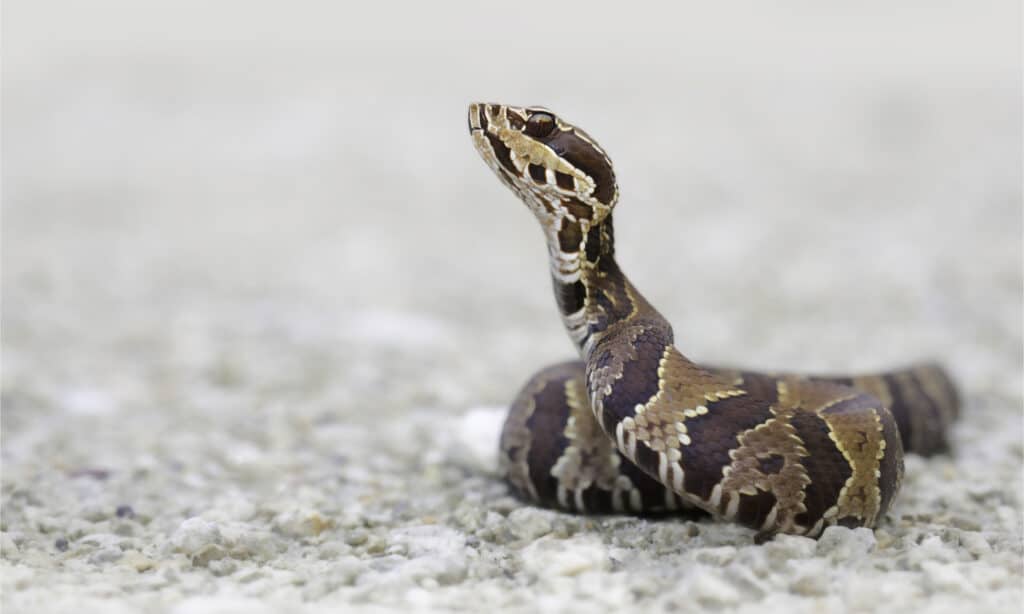
There are several species of snakes that live around the beach.
©Kristian Bell/Shutterstock.com
You may see several types of snakes around the beach, whether in the water, on the dunes, or in the wooded areas that make up maritime forests. These species can be both venomous and non-venomous, so it’s important to use precautions if you happen to stumble across one of these amazing reptiles during your beach day.
Ready to learn more about snakes that live on beaches? Here are six species that may be found!
Rattlesnake
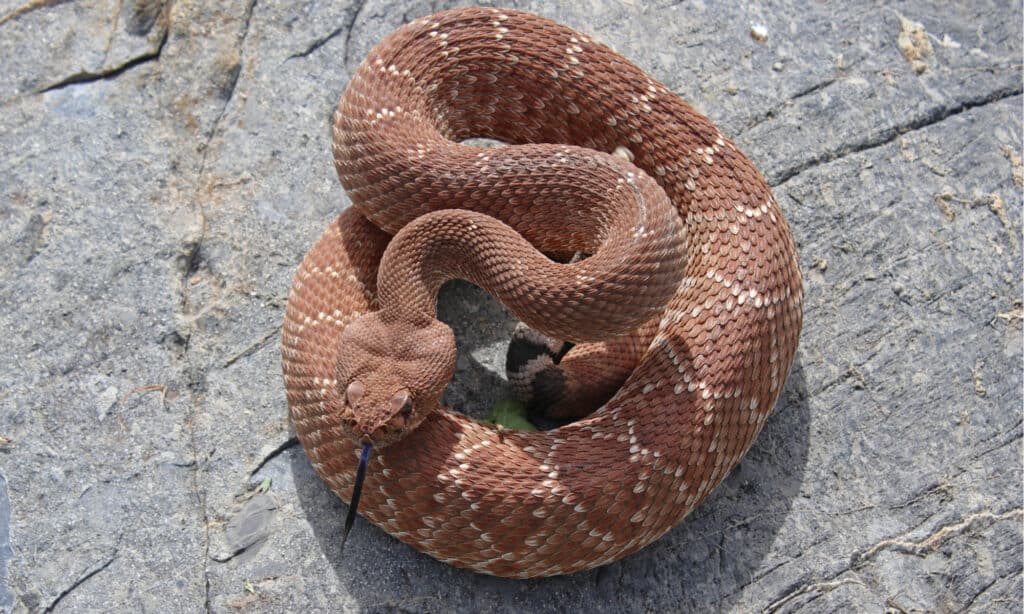
Rattlesnakes are a rare sight at the beach, but they do occasionally show up.
©Creeping Things/Shutterstock.com
Rattlesnakes are a rare sight on beaches. This is because, unlike sea snakes, they’re not adapted to salty conditions. However, they may slither in from the dunes or forest areas and make a surprise appearance. In fact, it was a rattlesnake that was spotted in the surf at Myrtle Beach!
There are several species of rattlesnakes that you may encounter around the beach. These are venomous species. Though they may be frightening, it’s important to reach out to professionals for help if you notice one in the surf. Rattlesnakes cannot survive long in saltwater, and because they play such a major role in the health of our ecosystems, it’s important to help preserve these species.
Coachwhip
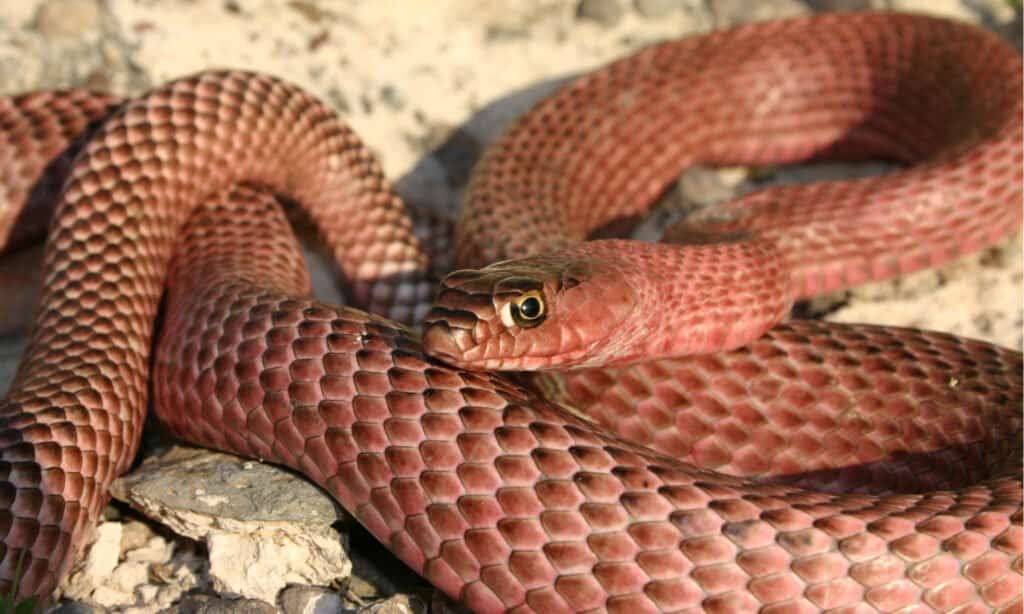
Coachwhip snakes are common around the sand dunes at the beach.
©Nathan A Shepard/Shutterstock.com
The coachwhip is a non-venomous snake that gets its name from its long, slender body that resembles a whip. There are six subspecies found across the United States and Mexico, and they’re a common sight at the beach.
Coachwhips live in many habitats, ranging from forests to suburban areas. However, they’re also known to thrive in the sand dunes at the beach where they have plenty of access to their preferred prey. Occasionally, you’ll also catch a stray coachwhip venturing out to explore the surf and sand!
Black Racer
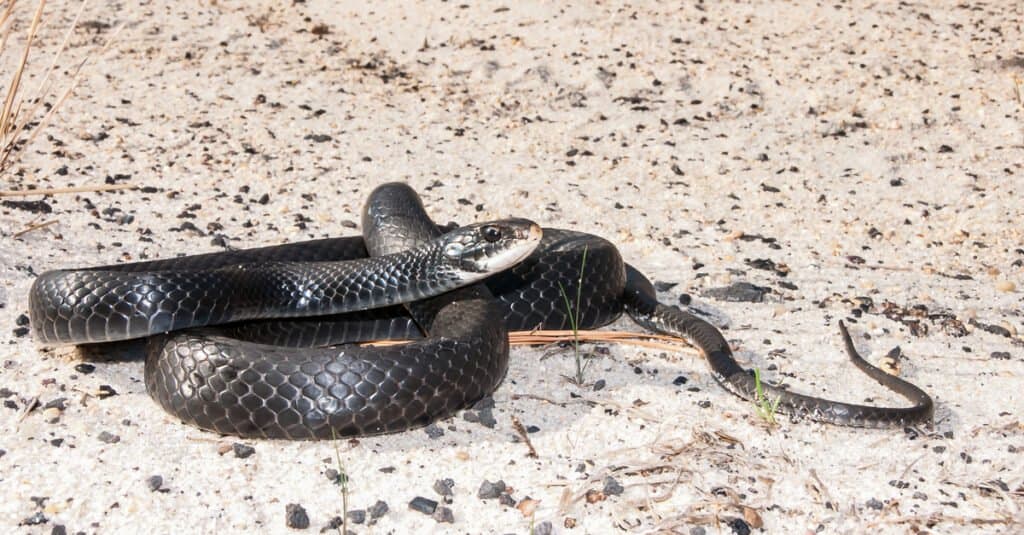
The
black racer
snake is common in states with beaches like Florida.
©Jay Ondreicka/Shutterstock.com
The black racer, also known as the eastern racer, is a large, black snake. They’re non-venomous, although their large size allows them to pack a painful bite.
Because the black racer is common in states with beaches, such as Florida, they may occasionally appear on the shore. This is especially true when human development occurs in their habitat and drives the black racer to relocate.
Eastern Indigo Snake
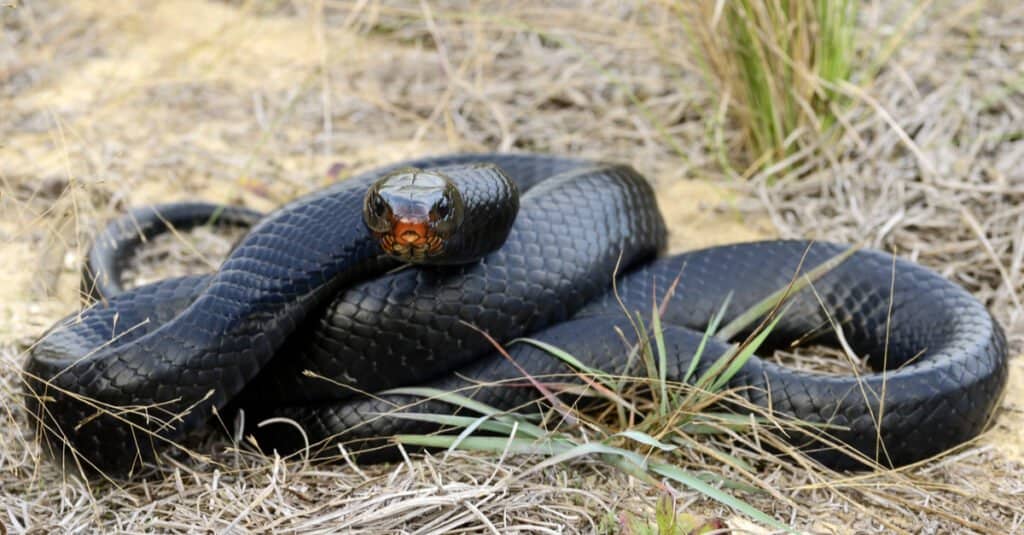
Snakes like the eastern indigo snake are often seen near beaches.
©Patrick K. Campbell/Shutterstock.com
The eastern indigo snake is the longest native species in North America. While they’re more likely to be found in the southern longleaf pine forests they call home, they will occasionally make their way to the beach.
Like the black racer, they’re a common sight in Florida, including in the Keys. They’ve even been found on Captiva Island!
Yellow-Bellied Sea Snake

Yellow-bellied sea snakes have dark stripes on their backs that turn into spots, helping you to identify them.
©Naganath R/Shutterstock.com
The yellow-bellied sea snake is probably one of the most common sea snakes to wash ashore. This fact may come as a surprise, especially since they’re the most aquatic of all sea snakes. However, strong currents, storms, and other events can bring the yellow-bellied sea snake to the beach.
Elegant Sea Snake

Elegant sea snakes are extremely venomous and can be dangerous when they appear on the beach.
©Rich Carey/Shutterstock.com
When the elegant sea snake comes to shore, it tends to make a rather noticeable splash. In fact, the last time this sea snake slithered onto shore, which was back in 2021, created quite an uproar on the news and social media.
However, it’s actually not common to spot them on the beach itself. Sea snakes like this species tend to live further out in the ocean. Although considered an aquatic reptile due to its ability to survive on the endless sea, you might find them on beaches from time to time.
Are Beach Snake Sightings Common?
Spending time at the beach is a popular pastime for many, but the possibility of encountering a snake can be a concern for some. While beach snake sightings are not unheard of, they are not very common.
In general, snakes are not adapted to living in saltwater environments, so they are not often found on beaches or in the ocean. However, there are a few species of snakes that may be encountered on or near the beach. For example, the salt marsh snake is a species that is commonly found in coastal areas and may be seen basking on the shoreline.
Another snake species that may be found near the beach is the diamondback water snake. These snakes are semi-aquatic and can be found in or near bodies of water, including lakes, rivers, and the ocean. However, they are generally not considered to be a danger to humans and will usually avoid contact if possible.
It is important to note that some species of venomous sea snakes may be found in coastal waters, but they are typically found in tropical or subtropical regions and are not commonly encountered in many areas. In addition, most species of sea snakes are not aggressive and will only bite if provoked.
The photo featured at the top of this post is © iStock.com/Javier_Art_Photography
Discover the "Monster" Snake 5X Bigger than an Anaconda
Every day A-Z Animals sends out some of the most incredible facts in the world from our free newsletter. Want to discover the 10 most beautiful snakes in the world, a "snake island" where you're never more than 3 feet from danger, or a "monster" snake 5X larger than an anaconda? Then sign up right now and you'll start receiving our daily newsletter absolutely free.
Thank you for reading! Have some feedback for us? Contact the AZ Animals editorial team.







